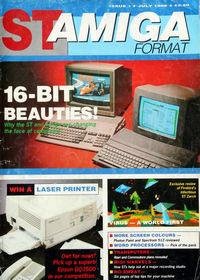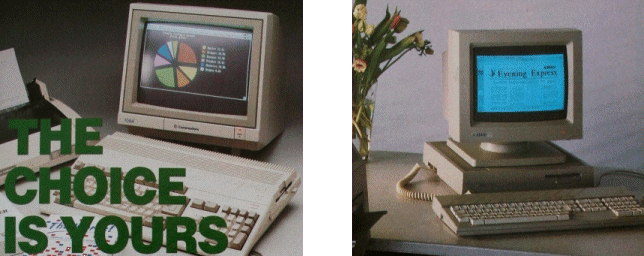
For business or pleasure, the machines making waves are Atari ST and Commodore Amigas. That's undisputable. But if you're a newcomer to the 16bit world or you fancy upgrading your current model, the problem is deciding which machine to choose. Each has its good points and each its bad. More confusing is that both manufacturers have introduced several versions of each computer - some are being pushed into the entertainment arena and others into the bacchana of business.
Machines are one thing. But what about software and support? Thankfully, there's no longer that nagging doubt. Software in out there - plenty of it, with new releases hitting the shelves every month. The same is true for hardware: there are enough add-ons to keep the most ardent gadget freak happy. Even Atari and Commodore are about to produce new machines; that can't be bad.
That’s the short term view. What will happen in six months, a year, even two years? The popular belief is that both machines are here to stay - in this country at least. In America the Amiga is seen as the machine to own; the converse is true in Germany where STs have the stronghold. This division is reflected globally - some countries have taken to the Amiga, some to the ST. It means good news for machine owners here, as foreign flavours in hardware and software will be around for a long time be come. Indeed, this is already much in evidence with many companies already flaunting imported goods.
Electric Avenue
In the beginning there was the 520ST. This useful beast had no Internal drive and GEM (the operating system) had to be booted from disk. Soon afterwards the 520STM arrived. This too had no in-built drive. But had the operating system embedded in ROM and a modulator socket for connection to a TV - hence the M in the name.
After the 520STFM - which now comes with a double - sided 80-track drive (take care when buying one that you're not palmed off with an earlier model with a single-sided drive) - came the 1040. And it was less than a year ago that the Mega, with larger memories and blitter, made an appearance in Britain.
Not to be outdone, Commodore introduced the A1000 with 256K of memory, Kickstart (the low - level operating system) on disk and a £1400 price tag shortly after the 520ST hit the streets. Those days are gone and so too has the A1000. In its place, Commodore sprung the A500 and A2000 on the world. The 500 has 512K (expandable to 1Mbyte) while the 2000 has 1 Mbyte (expandable to 4 Mbyte are slots for expansion cards).
Why so many versions of each computer? Commodore's line is that the 500 is a games machine, while the A2000, which can be made to emulate an IBM PC is being pushed as a business machine. It makes sense as the 2000 is well beyond the reach of most peoples pockets: the starting price is around £1100 for a single drive machine without monitor - not very useful in the office. Atari are taking a similar stance. The 520, and to a certain extent the 1040. are aimed at the lower end of the market - the entertainment sector. Atari's current bundling deal emphasises this point: 22 major games titles and a joystick thrown in with the 520 for the summer.
So what’s all the fuss about 16-bit? In one number, 68000. It’s the common factor that links be ST and Amiga. At the heart of both computers IS Motorola's 68000 silicon slither. This chip - which was announced in 1977 and appeared in 1979 - was conceived as a competitor to Intel's 8086/8088 (which has since found a happy home in IBM PC and its countless clones).
Sixteen-bit processors can handle big numbers, up to 65535, in a single operation. This in the most significant difference between 8-bit and 16-bit processors. Of course, its 14 different types of addressing mode, 17 registers capable of storing 32-bit numbers, relatively simple assembler syntax and the ability to address 16 megabytes of memory help to make it a firm favourite of software and hardware enthusiasts. The 68000 is the 16-bit beast causing the commotion and stealing the thunder form the aging 8-bitters (like the Z80 and 6502 which can be found in the Spectrums and C64s).
The Amiga and ST are the next generation of computer on the cutting edge of home micro technology. Obviously, other custom chips inside the computers help to make the machines what they are - Powerful
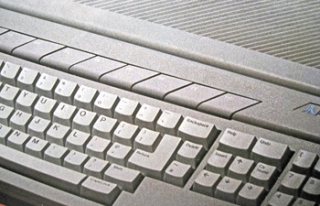
DRIVES
All STs come with a double-sided 80-track drive as standard. A second 1 Mbyte drive, the SF314, can be fitted which is helpful for disk and file copying. Hard disk drives for the ST are phenomenally priced. This stems from the fact that a special controller – which adds around £200 to the base price – is necessary. Atari’s 20 megabyte SH205 is just under £600.
GRAPHICS
The ST has three modes or resolutions and a palette of 512 colours; only two of the modes permit colour. This is controlled by the video chip, shifter. Low resolution offers 320 dots (pixels) across by 200 dots down with a maximum of 16 colours on screen at once. Medium resolution manages 640 pixels by 200 pixels with four colours on screen. Medium and low resolution can be displayed on a television or Atari’s SC1224 monitor. High resolution offers a whopping 640 by 400 image. The trade off is colour; there isn’t any. Only black and white pictures are produced and a special monitor, the SM125, is required. Neither horizontal scrolling nor sprites are available through hardware, although vertical scrolling is. The Megas come with a Blitter chip while the other STs can have one added which speeds animation.
SOUND
Sadly the STs sound chip, the Yamaha YM2149, leaves a lot to be desired. It’s only capable of producing square sound waves through three channels – similar to the chips in the Amstrad CPC and Spectrum +2 computers. However, the inclusion of MIDI ports means there’s a wealth of instruments that can be controlled from the ST.
EXPANSION
A non-standard 13-pin din lets you interface to either a high resolution monochrome monitor or a medium resolution colour monitor. A separate plug allows connection to a television. At present only the 520s come with the modulator. A parallel printer interface, RS232 (modem) interface, floppy disk interface, direct memory access port (for a hard disk), musical instrument interface (MIDI), plug-in cartridge port capable of supporting a 128K ROM and two 9-way plugs for joysticks and mouse are also standard on all machines. In addition to that lot the Mega STs have an internal bus expansion connector.
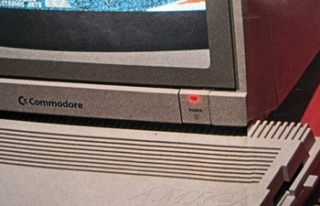
DRIVES
A second 3.5 inch 1 Mbyte drive, the A1010, is available and advisable. Hard drives for the A500 aren’t available from Commodore; and this situation doesn’t look to change in the near future. The A2000, on the other hand, can accept either an Amiga hard drive or A PC hard drive – it depends how you wish to use the machine (and how much you’re prepared to pay).
GRAPHICS
User-definable modes and a staggering palette of 4096 colours. Normal operational modes include 320 by 200 resolution with 32 colours on screen at once, 640 by 200 with 16 colours and a special hold-and-modify (HAM) mode which lets you have all 4096 displayed at the same time (restrictions come into play which makes this mode less than useful for animation). These modes can be displayed on television or Commodore’s 1082 monitor. Using a special technique called interlacing the Amiga can double its horizontal line count; a special long persistence monitor is required. With specialized chips like the Copper co-processor and Blitter chip the Amiga makes light work of shifting large amounts of screen memory. Amongst its facilities are eight 3-colour and four 15-colour hardware sprites.
SOUND
the custom Sound chip, affectionately called Paula (is she Spanish or Portuguese? - Ed), provides the Amiga with stunning Synthesizer-like musical power. Four voices can be used which have fully definable wave forms. Amplitude - or frequency-modulated sounds ace possible. And output is in stereo with two voices per channel.
EXPANSION
Analog RGB, digital RGB, monochrome (composite video) and standard television jacks are present on the A500. The A2000 offers RGB mono video only although, internally, it has an NTSC/PAL coder for composite video. A parallel printer interface, RS232 (modem) interface, floppy disk interface, 86-pin expansion connector, memory cartridge slot, audio outputs, lightpen jack and two 9-way plugs for joysticks and mouse are also standard on both machines. The 2000 also has several internal slots for PC cards and futher expansion.
Machine Choice
Which machine is best for you? Decisions, decisions… we can't may: them for you, but we can certainly put you on the fight track. Do you want to use your machine in an office environment? Do you envisage your machine controlling your robotic armadillo? Perhaps you see yourself spending hours in front of a monitor pumping out red-hot code? Or do you plan to stop the aliens from touching down? You know what you want to do with a computer, all you have to do is decide which machine will do the job best. Easy really.
Follow our tables to help you out of your quandary. They show the various models available and the wadge of notes each demands.
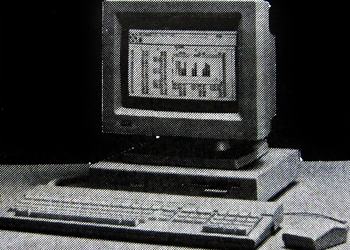
The Mega's sleek design hides the legendary blitter graphics chip.
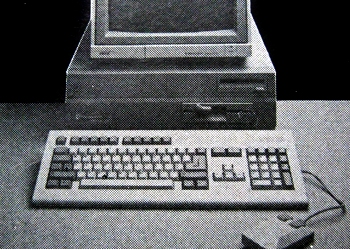
Commodore's A2000.. Trapped within are specialist chips Fat Angus, Denise and Paula
Other Sources
The price of most official peripherals will certainly lessen the weight in your wallet; a third-party offering may prove a wiser choice. For instance, Atari's colour monitor, excellent as it may be, drops in at a penny under £400.
Commodore's monitor isn't much cheaper (£350). The Philips 8833 at around £250 seems to be the favourite of many dealers, There are other options, but it's best to hunt around and decide exactly want you want ant how much you care to fork out.
Ideally the Amiga's interlace mode requires a high-persistence monitor to cut out the flicker, Mitsubishi manufacture many. But there are several factors to take into consideration: screen size, degree of persistence, size of gun and so on. Whatever you choose, it will cost you upwards of £500.
Hard drives - and, indeed, external disk drives - are another sore point.
Commodore don't make a hard drive for the Amiga A500 so you have no choice but to seek elsewhere. Try Precision on 01-3307166. They distribute the Supra hard drive which costs £699.95 and has 20 megabytes of storage. Probably the cheapest 20 megabyte hard drive for the ST is the one offered by Silicon Systems (061-848 8959); Big Disc. Cost is £549. Look around for external drives. It should be possible to pick one up for a sprinkling under £100.
| Atari | £ | Commodore | £ | |
| Computers | 520STFM 1040STF Mega ST2 Mega ST4 |
399.99 599.99 1034.99+ 1379.9+ |
A500 A2000 |
499.99 1100* |
| Monitors | SM125 mono SC1224 colour |
149.99 399.99 |
520 modulator 1084 colour |
24.99 349.99 |
| Drives | SF314 3.5 inch SH205 20 meg |
159.99 599.99 |
1010 3.5 inch 20 meg PC 20 meg Amiga |
149.99 630.00* 730.00* |
* Prices are approximate and will vary from dealer to dealer
| Atari ST | Commodore Amiga | ||
|---|---|---|---|
| Art and design | Has less colours than the Amiga. 520STFM comes with modulator for connection to TV, but for serious work the SC1224 monitor is required. | Favorite with artists. A500 can be connected to a TV via modulator, but 1084 colour monitor is best for detailed design. | |
| Business software | A monochrome monitor, second drive - preferably hard - and large memory are the usual requirements for business applications. | The A2000 is regarded as the business machine. Its PC emulation option gives access to thousands of applications and utilities. | |
| TP | Large memory machines, monochrome monitor and Atari’s laser printer make a perfect combination. Hard drive recommended. | Impractical on A500 due to lack of memory. A20 with hard drive is fine, although third-party laser printer is needed. | |
| Games | Disappointing three channel sound chip. Midi ports are included but Software requires lots of memory | Custom four-channel sound chip capable of AM and FM synthesis. Sound reproduced in startling stereo. | |
| Music | Large selection getting better all the time The minimum spec 520 with modulator or colour TV is fine. | Graphically and musically excellent. However, relatively few titles are produced for it. A500 adequate | |
| Programming | Bundled BASIC is poor and car leave beginners floundering. However lots of other languages are available. | Excellent BASIC comes with the machines. Lower level programming is tough as the machine has a very closed architecture. | |
| Word Processing | Monochrome monitor is best. The more memory the machine has, the easier document handling becomes. | A second drive is a good idea. So too is the A200 simply because it has more memory. |
Perihelion Hardware of Cambridge - best known for their work on the Atari Abaq transputer-based machine - are currently prototyping an ST laptop computer. Although little is known about the machine, rumours have it that it will be available around Christmas priced at under £600. Also on Atari's list is a 104OSTFM which, logically, will have a modulator included.

